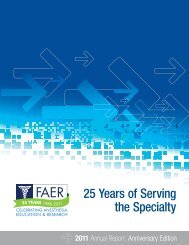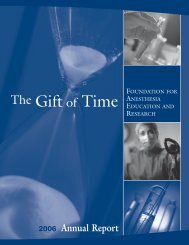2010 MSARF Symposium Participants - Foundation for Anesthesia ...
2010 MSARF Symposium Participants - Foundation for Anesthesia ...
2010 MSARF Symposium Participants - Foundation for Anesthesia ...
Create successful ePaper yourself
Turn your PDF publications into a flip-book with our unique Google optimized e-Paper software.
was matched on year of delivery and the other was matched on year of delivery, maternal age and race. Comorbidity<br />
Software v3.6 was used to compute CCS from ICD-9-CM codes. Conditional logistic regression modeling was used to<br />
estimate the odds ratios (ORs) while adjusting <strong>for</strong> patient characteristics and delivery mode.<br />
Results: Overall, 18% of the cases and 2.5% of the controls had an elevated CCS (≥1). Compared to women with a<br />
CCS=0, risk of maternal mortality tripled <strong>for</strong> women with CCS=1 (adjusted OR 2.97; 95% CI 1.56-5.65) and increased by<br />
14 fold <strong>for</strong> women with CCS ≥2 (adjusted OR 14.1; 95% CI 5.53-35.8). Approximately 16% of all the maternal<br />
mortalities were attributable to elevated CCS.<br />
Conclusions: CCS is a major, independent predictor of maternal mortality risk and might be used as a simple screening<br />
tool in prenatal care to identify high-risk women <strong>for</strong> clinical interventions.<br />
Student Name: Michael Topf<br />
Host Department: University of Rochester<br />
Primary Mentor Name: Gail V.W. Johnson, PhD, Professor Department of Anesthesiology<br />
Title of Research Project: Developing Alzheimer disease therapeutics: Does the activation of the Nrf2 pathway<br />
protect against tau toxicity?<br />
Alzheimer disease (AD), the leading cause of dementia, affects 5.3 million Americans and millions more worldwide.<br />
Tau, the protein that accumulates as neurofibrillary tangles (NFT) in AD brain, is a microtubule-associated protein that<br />
stabilizes microtubules and regulates axonal transport. However, recent research suggests that pathological <strong>for</strong>ms of tau<br />
that precede NFT <strong>for</strong>mation are the toxic species in AD. In addition, caspase-cleavage of tau at Asp-421 plays a role in<br />
the <strong>for</strong>mation of pathological tau. Because tau undergoes this abnormal posttranslational processing in the early stages of<br />
AD, it is believed that these modifications are central to its toxicity. Concurrent with these changes in tau is the<br />
development of mitochondrial abnormalities. In AD, the ability of the mitochondria to buffer increases in cytosolic<br />
calcium, regulate oxidative stress, and produce ATP is impaired which results in neuronal cell death. To regulate<br />
oxidative stress and eliminate reactive oxygen species (ROS) the cell activates the Nrf2 pathway. Recent research<br />
suggests that curcumin, and other electrophiles such as sul<strong>for</strong>aphane, may have neuroprotective effects in the treatment of<br />
AD. Because the Nrf2 pathway is responsive to a broad range of electrophiles, the pharmacological prophylactic<br />
activation of the Nrf2 pathway is a real possibility <strong>for</strong> treatment of AD. With upregulation of the Nrf2 pathway the<br />
negative effects from the ROS can be countered, thus limiting damage to the cell. This research aims to further<br />
investigate the manner in which curcumin and sul<strong>for</strong>aphane activate the Nrf2 pathway and whether this has an effect on<br />
cell viability.<br />
Student Name: Janelle Tryjankowski<br />
Host Department: Thomas Jefferson University<br />
Primary Mentor Name: Jeffrey Joseph, DO<br />
Additional Mentors: Brian Hipszer, PhD; Channy Loeum; Jung-Won Park, MD<br />
Title of Research Project: Perioperative hyperglycemia and glycosuria lead to dehydration and oliguria<br />
In the perioperative period, urine volume and color are commonly used to assess a patient’s hydration status and to<br />
estimate the adequacy of renal perfusion. However, due to the stress response or to poor glycemic management, there is<br />
an incidence of hyperglycemia during surgery. This can cause glucose to overwhelm renal reabsorption and to “spill<br />
over” into the urine, leading to an unaccounted <strong>for</strong> osmotic diuresis, and thus a deceivingly high urine output <strong>for</strong> the<br />
patient's hydration status. There<strong>for</strong>e, glycosuria calls into question the reliability of using urine volume and color as<br />
markers of hydration status and renal perfusion. The primary objective of this observational study is to determine the<br />
associations between plasma glucose levels and the rate of urine production, urine color, urine specific gravity, and the<br />
concentration of glucose in the urine (i.e. the threshold <strong>for</strong> glycosuria) in both diabetic and non-diabetic surgical patients.<br />
Blood samples from intravascular catheters and fingersticks were analyzed <strong>for</strong> plasma glucose. Subcutaneous continuous<br />
glucose sensors recorded changes in interstitial fluid glucose. Urine samples were analyzed <strong>for</strong> various components,<br />
including glucose, to quantify glycosuria. Thus far, we have observed that in patients with significant glycosuria<br />
(>50mg/dL), there is a concomitant drop in blood pressure, rise in heart rate, and delayed decrease in urine output due to<br />
27





